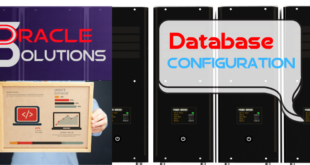How to Find and repair Corrupt block in database
Step 1: Below query will show if there is any corrupted block
SELECT *
FROM v$database_block_corruption — will show if any corruped block
Step 2: Below query can give you Detail information about corrupted block:
set head ON;
set pagesize 2000
set linesize 250
SELECT *
FROM v$database_block_corruption;
SELECT e.owner,
e.segment_type,
e.segment_name,
e.partition_name,
c.file#,
Greatest(e.block_id, c.block#)
corr_start_block#,
Least(e.block_id + e.blocks – 1, c.block# + c.blocks – 1) corr_end_block#
,
Least(e.block_id + e.blocks – 1, c.block# + c.blocks – 1) –
Greatest(e.block_id, c.block#) + 1
blocks_corrupted,
NULL description
FROM dba_extents e,
v$database_block_corruption c
WHERE e.file_id = c.file#
AND e.block_id <= c.block# + c.blocks – 1
AND e.block_id + e.blocks – 1 >= c.block#
UNION
SELECT s.owner,
s.segment_type,
s.segment_name,
s.partition_name,
c.file#,
header_block corr_start_block#,
header_block corr_end_block#,
1 blocks_corrupted,
‘Segment Header’ description
FROM dba_segments s,
v$database_block_corruption c
WHERE s.header_file = c.file#
AND s.header_block BETWEEN c.block# AND c.block# + c.blocks – 1
UNION
SELECT NULL owner,
NULL segment_type,
NULL segment_name,
NULL partition_name,
c.file#,
Greatest(f.block_id, c.block#)
corr_start_block#,
Least(f.block_id + f.blocks – 1, c.block# + c.blocks – 1) corr_end_block#
,
Least(f.block_id + f.blocks – 1, c.block# + c.blocks – 1) –
Greatest(f.block_id, c.block#) + 1
blocks_corrupted,
‘Free Block’ description
FROM dba_free_space f,
v$database_block_corruption c
WHERE f.file_id = c.file#
AND f.block_id <= c.block# + c.blocks – 1
AND f.block_id + f.blocks – 1 >= c.block#
ORDER BY file#,
corr_start_block#;
Step 4: Collect file ids
SELECT DISTINCT file_id
FROM dba_extents;
Step 5: Collect details
SELECT file_id,
segment_name,
segment_type,
owner,
tablespace_name,
block_id,
blocks
FROM sys.dba_extents
WHERE ( file_id BETWEEN 2 AND 19 )
AND 468598 BETWEEN block_id AND block_id + blocks – 1;
Step 6: Repair
a) Collect all data to temporary table and collect all DDL script and grants.
b) drop the table and re-create it with DDL script. (Disable refence key before drop, enable after create table)
c) Insert all records to the table
Note: This entire activity should not be taken in prod databases without Oracle support’s recommendation.
 Oracle Solutions We believe in delivering tangible results for our customers in a cost-effective manner
Oracle Solutions We believe in delivering tangible results for our customers in a cost-effective manner

